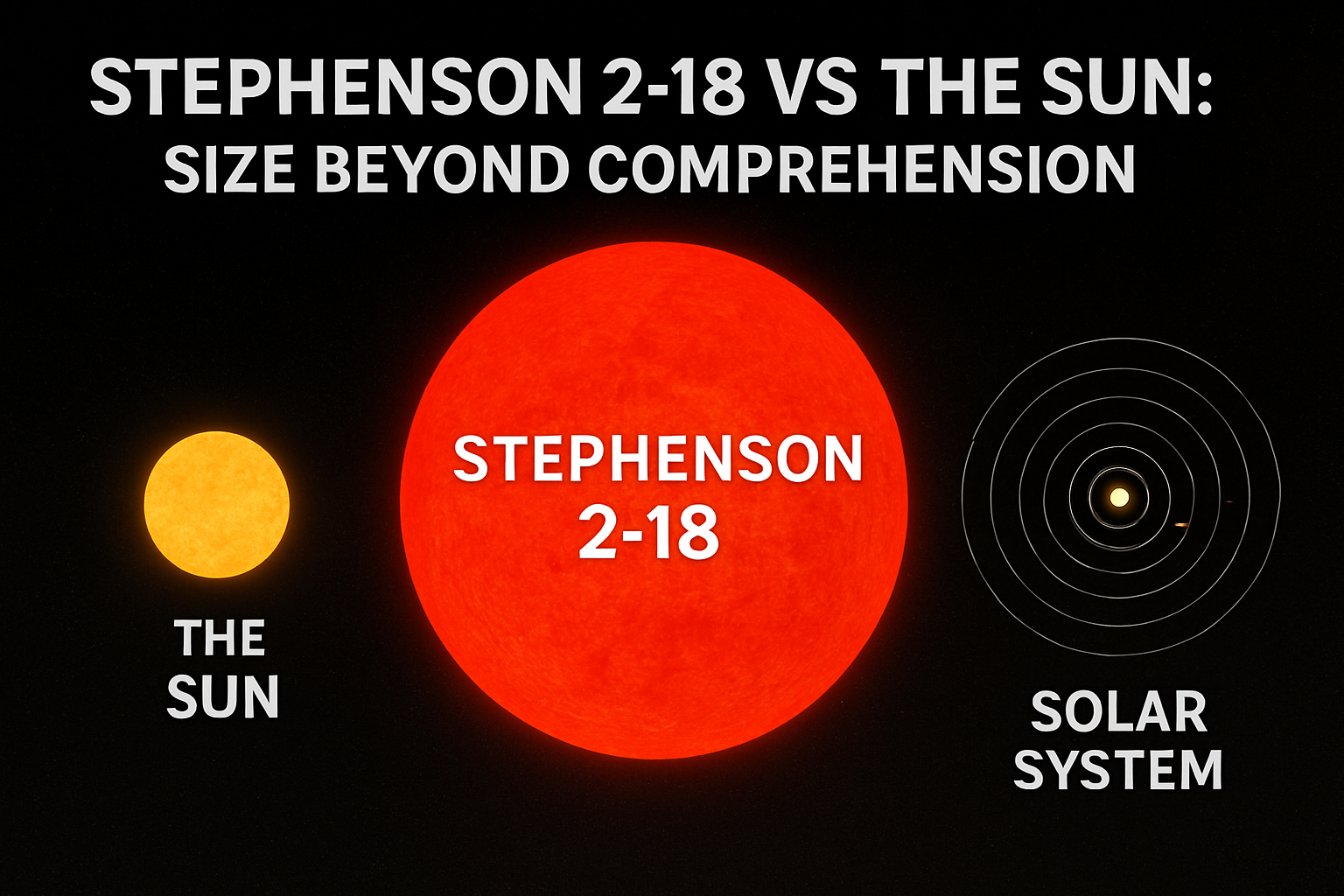Stephenson 2-18 vs The Sun: Size Beyond Comprehension
Introduction
When we gaze up at the sky, the Sun appears unimaginably large — a blazing sphere of gas so immense it contains 99.8% of all the mass in our solar system. It gives us warmth, light, and energy, sustaining every form of life on Earth. Yet in the grand theater of the universe, our Sun is an ordinary star — modest in size, brightness, and power. To truly comprehend how small it is on the cosmic stage, we only need to compare it with one of the universe’s giants: Stephenson 2-18, a red hypergiant so colossal that its size almost defies human comprehension.
This comparison not only humbles us but also opens a window into the scale of the cosmos, reminding us of how much remains beyond our understanding.
The Sun: Our Familiar Star
The Sun is classified as a G-type main-sequence star (G dwarf), often referred to as a yellow dwarf. It has:
- Diameter: about 1.39 million kilometers
- Radius: about 696,000 kilometers
- Mass: 1.989 × 10³⁰ kilograms
- Volume: capable of fitting over 1.3 million Earths inside it
To us, this is staggering. The Sun is so large that if it were hollow, more than a million Earths could fit inside. It’s so massive that it warps space-time itself, keeping all planets, moons, asteroids, and comets bound within its gravitational grip.
But on the galactic scale, the Sun is utterly average. It sits comfortably in the main sequence, quietly fusing hydrogen into helium for about 4.6 billion years and likely to continue doing so for another 5 billion years. In cosmic terms, the Sun is stable, modest, and middle-aged.
Stephenson 2-18: The Giant Among Giants
Now enter Stephenson 2-18, a red hypergiant star discovered in the 1970s. Located in the Stephenson 2 star cluster, around 19,000 light-years from Earth in the constellation Scutum, it is considered the largest known star by radius.
Its measurements are almost beyond belief:
- Radius: about 2,150 times that of the Sun
- Diameter: nearly 3 billion kilometers across
- Volume: enough to fit 10 billion Suns inside
- Luminosity: approximately 440,000 times that of the Sun
If placed in the center of our solar system, Stephenson 2-18 would engulf Mercury, Venus, Earth, Mars, Jupiter, and even Saturn. Its surface would stretch far past the orbit of Saturn, possibly nearing Uranus. The scale is so immense that human comparisons almost collapse under its weight.
The Numbers in Perspective
Numbers on paper can feel abstract, so let’s break them down with more vivid comparisons:
- The Sun vs Earth:
- Earth’s diameter is about 12,742 km.
- The Sun is 109 times wider than Earth.
- Stephenson 2-18 vs Sun:
- Stephenson 2-18 is about 2,150 times wider than the Sun.
- In volume, Stephenson 2-18 is so vast that you could fit over 10 billion Suns inside it.
- Stephenson 2-18 vs Solar System:
- The Sun reaches just beyond Earth’s orbit in terms of light and warmth.
- Stephenson 2-18, if it replaced the Sun, would consume Saturn’s orbit and leave no room for most of our planetary system.
Imagine our entire solar system — every planet from Mercury to Saturn — swallowed whole inside a single star. That is Stephenson 2-18.
Why Is Stephenson 2-18 So Big?
Stephenson 2-18 is a red hypergiant, an extremely rare type of star. Hypergiants form when very massive stars burn through their fuel at furious rates. Instead of the steady stability of a main-sequence star like the Sun, hypergiants live short, chaotic lives:
- They expand rapidly, their outer layers ballooning outward.
- They burn fuel so quickly that their life span may be only a few million years — a blink of an eye in cosmic terms.
- They lose mass at incredible rates, shedding material into space in powerful stellar winds.
Stephenson 2-18 is approaching the end of its life. One day, it will likely collapse in a dramatic supernova explosion, perhaps leaving behind a black hole or neutron star. This violent ending contrasts sharply with the Sun’s more peaceful fate as a red giant that will eventually shed its outer layers to form a planetary nebula.
Beyond Human Comprehension
To truly grasp the difference in size, we need metaphors:
- If the Sun were the size of a basketball, Stephenson 2-18 would be a sphere stretching nearly two and a half kilometers wide.
- Light takes about 8 minutes to travel from the Sun to Earth. But to cross Stephenson 2-18 from one side to the other, light would take more than 8 hours.
This scale is so overwhelming that it breaks our ordinary sense of measurement. Humans evolved to think in terms of meters, kilometers, and days. Stars like Stephenson 2-18 force us to stretch our imagination into billions and trillions — a realm where ordinary intuition fails.
What This Teaches Us About the Universe
Comparisons like this reveal three profound truths:
- The Universe Is Vast Beyond Imagination
Our solar system, and even our Sun, is just a speck in a galaxy of hundreds of billions of stars — some unimaginably larger. - Scale Shapes Perspective
What feels “big” to us (the Sun) is tiny compared to what the cosmos can produce. This humbles our place in the universe and sparks curiosity. - Cosmic Diversity
Stars come in an astonishing range of sizes, lifespans, and fates. From small, cool red dwarfs that burn for trillions of years, to giants like Stephenson 2-18 that live fast and die young, the universe is a laboratory of extremes.
The Future of Both Stars
- The Sun’s Future: In about 5 billion years, the Sun will expand into a red giant, swelling to engulf Mercury, Venus, and perhaps Earth. Eventually, it will shed its outer layers, leaving behind a white dwarf.
- Stephenson 2-18’s Future: Within a few million years, it will end in a supernova, possibly collapsing into a black hole. Its explosive death will scatter heavy elements like iron, gold, and uranium into space — the very building blocks for future planets and life.
This difference highlights the varied destinies of stars depending on their size and mass.
Conclusion
The comparison between the Sun and Stephenson 2-18 is more than a simple contest of size. It’s a reminder of how vast and varied the universe is, and how small our place within it can feel. The Sun may seem incomprehensibly massive to us, yet it is a mere flicker compared to giants like Stephenson 2-18.
In the end, this “size beyond comprehension” teaches us humility and wonder. It pushes us to imagine scales far beyond human experience and inspires us to keep exploring the cosmos. For every Stephenson 2-18 we find, countless other mysteries await, each more mind-bending than the last.







Terrific work! This is the type of information that should be shared around the net. Shame on Google for not positioning this post higher! Come on over and visit my site . Thanks =)